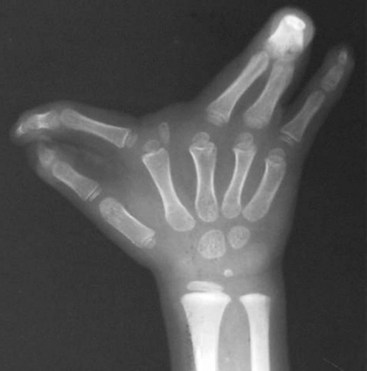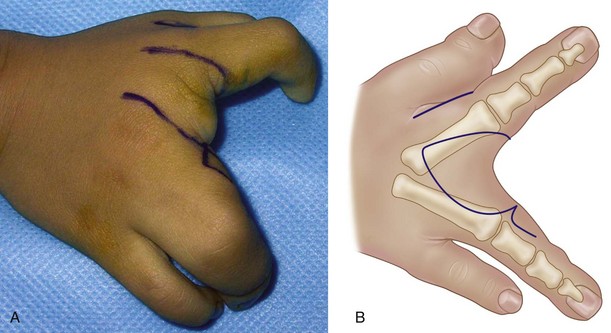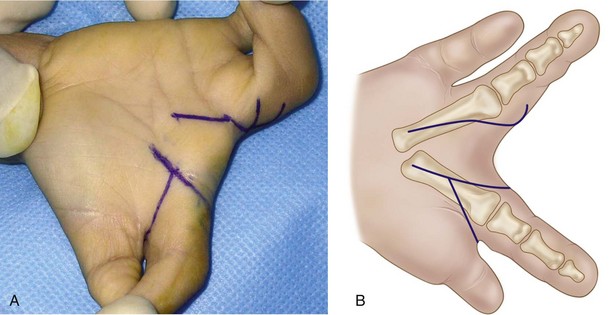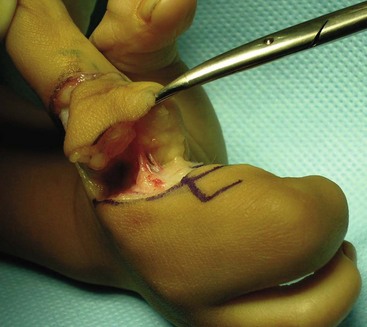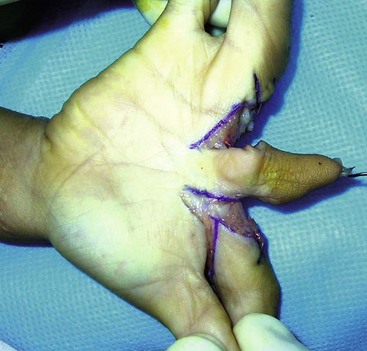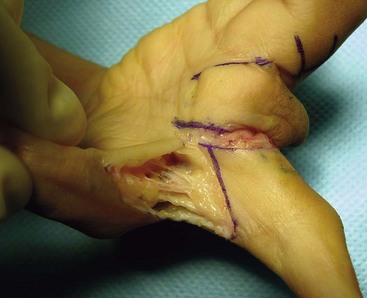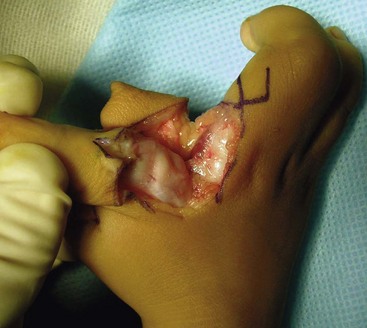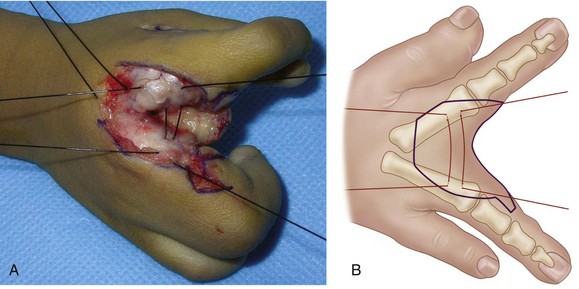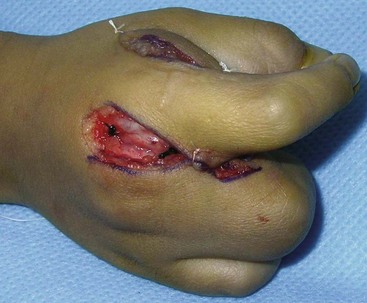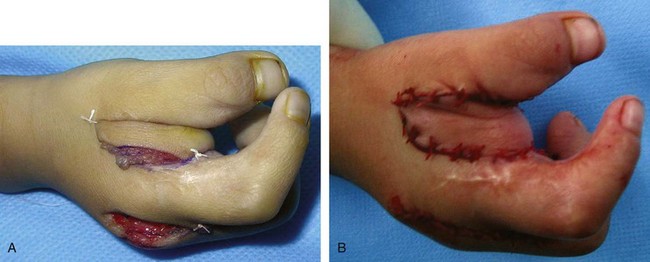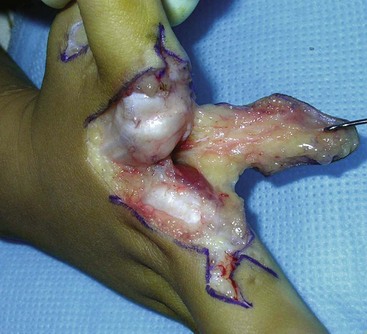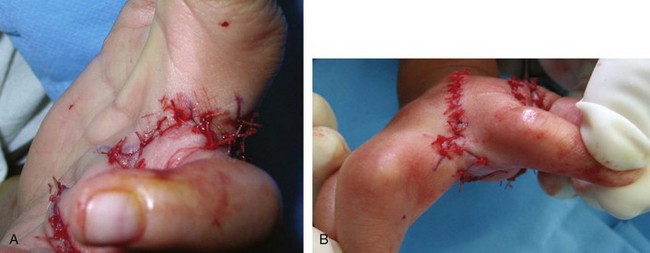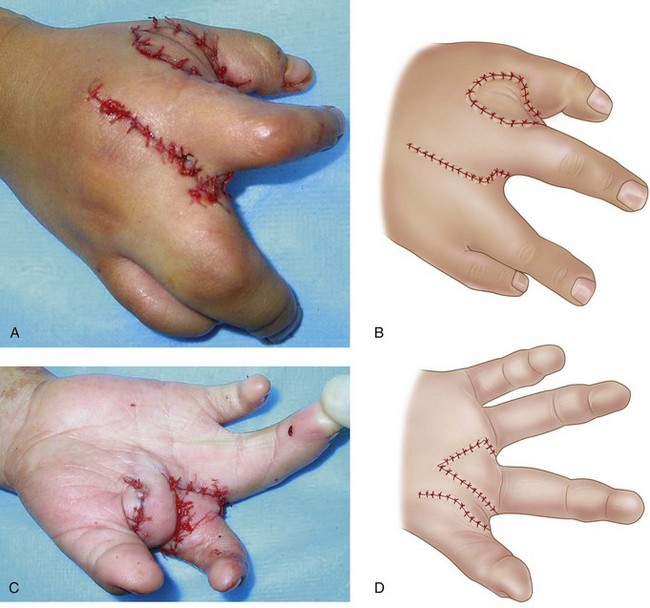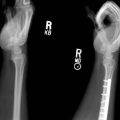Procedure 42 Cleft Hand Reconstruction
Examination/Imaging
Clinical Examination
 A cleft hand is considered a longitudinal deficiency affecting the central digits. It is commonly inherited as an autosomal dominant trait with variable penetrance. The condition may be bilateral and may involve the feet. Manske and Halikis have proposed a classification based on the status of the first web space that is useful in planning treatment (Table 42-1).
A cleft hand is considered a longitudinal deficiency affecting the central digits. It is commonly inherited as an autosomal dominant trait with variable penetrance. The condition may be bilateral and may involve the feet. Manske and Halikis have proposed a classification based on the status of the first web space that is useful in planning treatment (Table 42-1).
 Patients with a typical cleft hand present with a V-shaped cleft in the center of the hand. This is occasionally associated with absence, polydactyly, and/or syndactyly of one or more digits. The cleft may be minor or major with absence of one or more digits. The absence progresses from the radial to the ulnar side. Polydactyly/syndactyly involves the digits adjacent to the cleft. Proximal muscle tendon units and nerves may be variably absent.
Patients with a typical cleft hand present with a V-shaped cleft in the center of the hand. This is occasionally associated with absence, polydactyly, and/or syndactyly of one or more digits. The cleft may be minor or major with absence of one or more digits. The absence progresses from the radial to the ulnar side. Polydactyly/syndactyly involves the digits adjacent to the cleft. Proximal muscle tendon units and nerves may be variably absent.
 There is a strong genetic component associated with hand clefts, and genetic counseling is helpful.
There is a strong genetic component associated with hand clefts, and genetic counseling is helpful.
Table 42-1 Classification of Cleft Hand (Manske and Halikis)
| Type | Description | Characteristics |
|---|---|---|
| I | Normal web | Thumb web space is not narrow |
| IIA | Mildly narrowed web | Thumb web space is mildly narrow |
| IIB | Severely narrowed web | Thumb web space is severely narrowed |
| III | Syndactylized web | Thumb and index rays syndactylized, web space obliterated |
| IV | Merged web | Index ray suppressed, thumb web space merged with the cleft |
| V | Absent web | Thumb elements suppressed, ulnar rays remain, thumb web space no longer present |
Imaging
 Radiographs of the hand and upper limb are necessary for all congenital hand problems to identify other areas of concern.
Radiographs of the hand and upper limb are necessary for all congenital hand problems to identify other areas of concern.
 Metacarpal anomalies are frequently noticed. These include absence of metacarpals within the cleft, transverse tubular bones that widen the cleft with growth, bifid metacarpals supporting one finger, and duplication. Phalangeal anomalies include longitudinally bracketed epiphyses or double phalanges.
Metacarpal anomalies are frequently noticed. These include absence of metacarpals within the cleft, transverse tubular bones that widen the cleft with growth, bifid metacarpals supporting one finger, and duplication. Phalangeal anomalies include longitudinally bracketed epiphyses or double phalanges.
Exposures
 In children who have a central cleft with narrow thumb and index finger web, the skin over the dorsum of the cleft is raised as a palmar-based flap. This flap is used to resurface the narrow thumb and index finger web after it is released. Elevating this flap on the dorsum is easier because of a lack of adhering palmar fascia. Additionally, this allows access to the metacarpal heads that can be sutured together to close the cleft.
In children who have a central cleft with narrow thumb and index finger web, the skin over the dorsum of the cleft is raised as a palmar-based flap. This flap is used to resurface the narrow thumb and index finger web after it is released. Elevating this flap on the dorsum is easier because of a lack of adhering palmar fascia. Additionally, this allows access to the metacarpal heads that can be sutured together to close the cleft.
 A distally based rectangular flap is designed over the midproximal phalanx on one of the fingers adjoining the cleft. This flap will be used to create the web space formed after closure of the central cleft. An important consideration is to create a smooth slope in the web space.
A distally based rectangular flap is designed over the midproximal phalanx on one of the fingers adjoining the cleft. This flap will be used to create the web space formed after closure of the central cleft. An important consideration is to create a smooth slope in the web space.
 Figures 42-1 and 42-2 show a 2-year-old boy with a central cleft between the index and long fingers, a tight thumb and index finger web space, and complete complex syndactyly between the long and ring fingers. The syndactyly will need to be released in a second operation.
Figures 42-1 and 42-2 show a 2-year-old boy with a central cleft between the index and long fingers, a tight thumb and index finger web space, and complete complex syndactyly between the long and ring fingers. The syndactyly will need to be released in a second operation.
Procedure
Cleft Hand Reconstruction
Step 1: Elevation of Palmar-Based Cleft Flap
 A palmar-based flap is designed, extending to the dorsum of the hand by parallel incisions (Figs. 42-3 and 42-4).
A palmar-based flap is designed, extending to the dorsum of the hand by parallel incisions (Figs. 42-3 and 42-4).
 The parallel incisions are connected on the dorsum, and the dorsal flap is elevated superficial to the extensor tendons (Fig. 42-5).
The parallel incisions are connected on the dorsum, and the dorsal flap is elevated superficial to the extensor tendons (Fig. 42-5).
 The neurovascular bundles are identified on the palmar aspect and protected, and the flap is mobilized by dividing any strands of palmar fascia (Fig. 42-6).
The neurovascular bundles are identified on the palmar aspect and protected, and the flap is mobilized by dividing any strands of palmar fascia (Fig. 42-6).
Step 2: Release of Thumb and Index Finger Web Space
Step 3: Closure of Cleft
Step 4: Transfer of Cleft Flap to Resurface Thumb and Index Finger Web
Step 5: Creation of New Web Space in Cleft
Postoperative Care and Expected Outcomes
 The hand is splinted for 4 weeks to allow healing of the intermetacarpal closure.
The hand is splinted for 4 weeks to allow healing of the intermetacarpal closure.
 No therapy is necessary after splint removal. The child is followed yearly to evaluate the growth of the hand. Creeping of the web space is not uncommon with cleft surgery. Future web space releases may be needed to enhance the functional and aesthetic results for the hand. The outcome depends on the degree of preoperative deformity, and good function can be achieved in children with a preserved thumb.
No therapy is necessary after splint removal. The child is followed yearly to evaluate the growth of the hand. Creeping of the web space is not uncommon with cleft surgery. Future web space releases may be needed to enhance the functional and aesthetic results for the hand. The outcome depends on the degree of preoperative deformity, and good function can be achieved in children with a preserved thumb.







